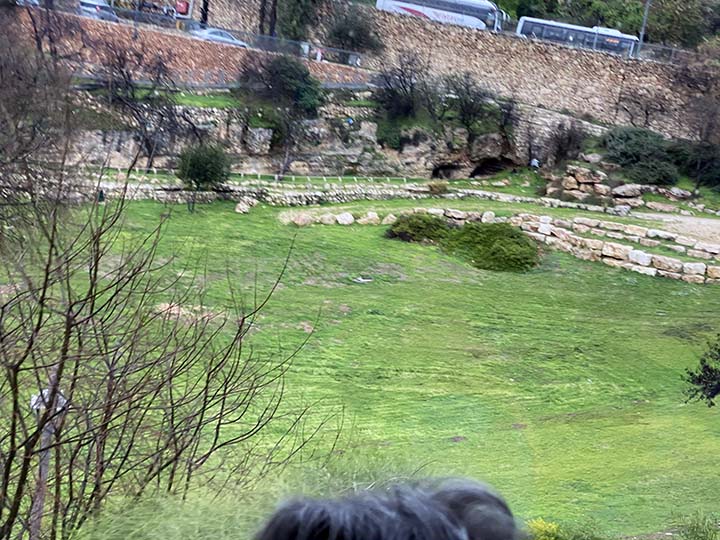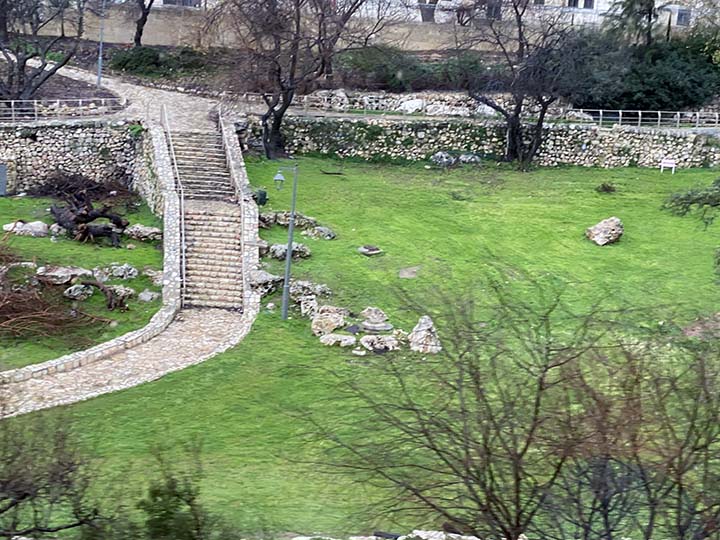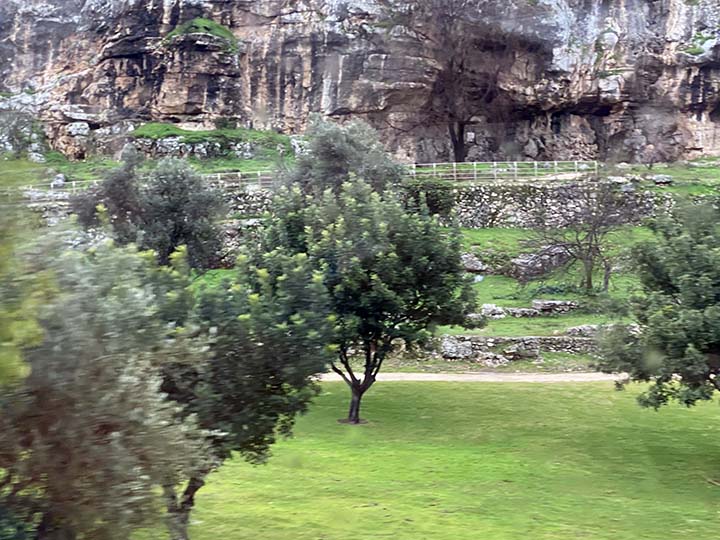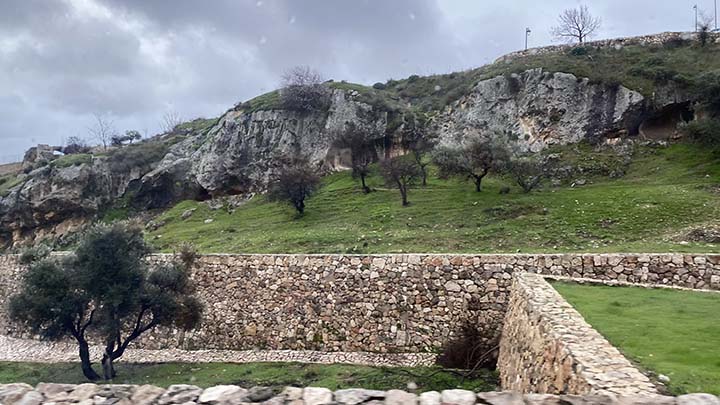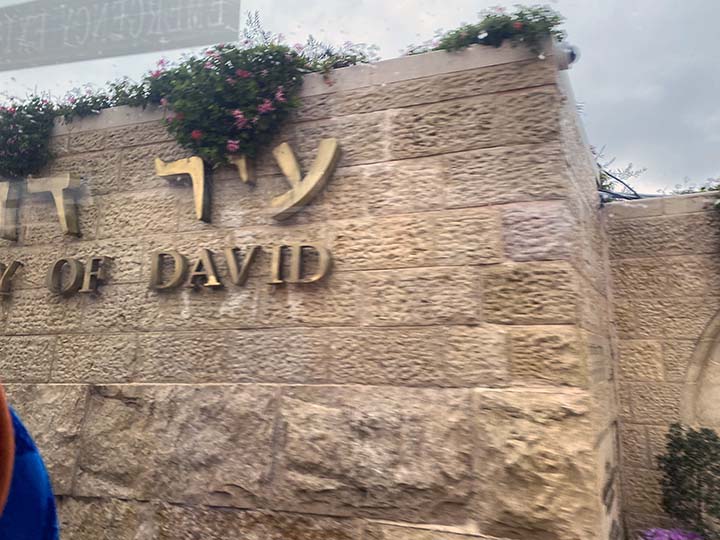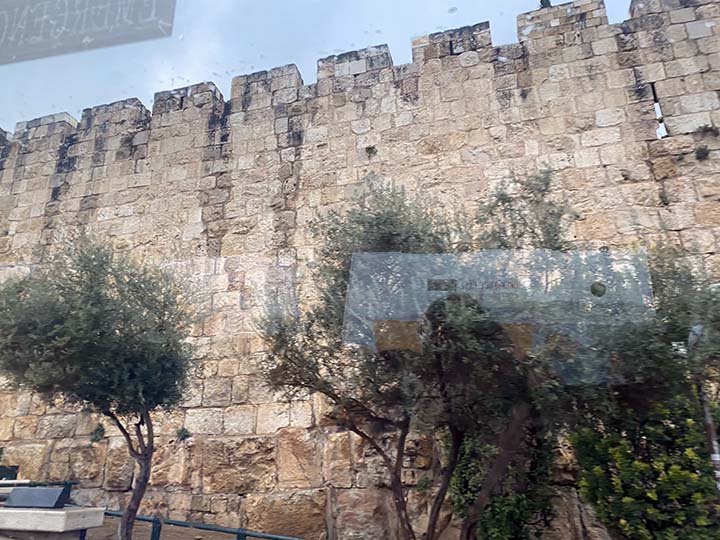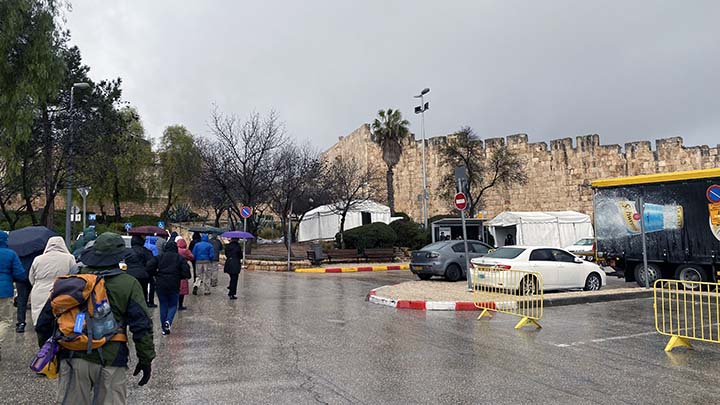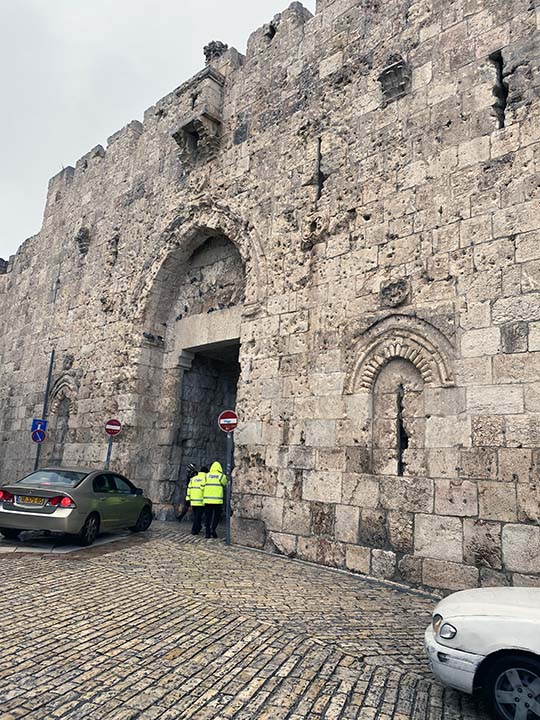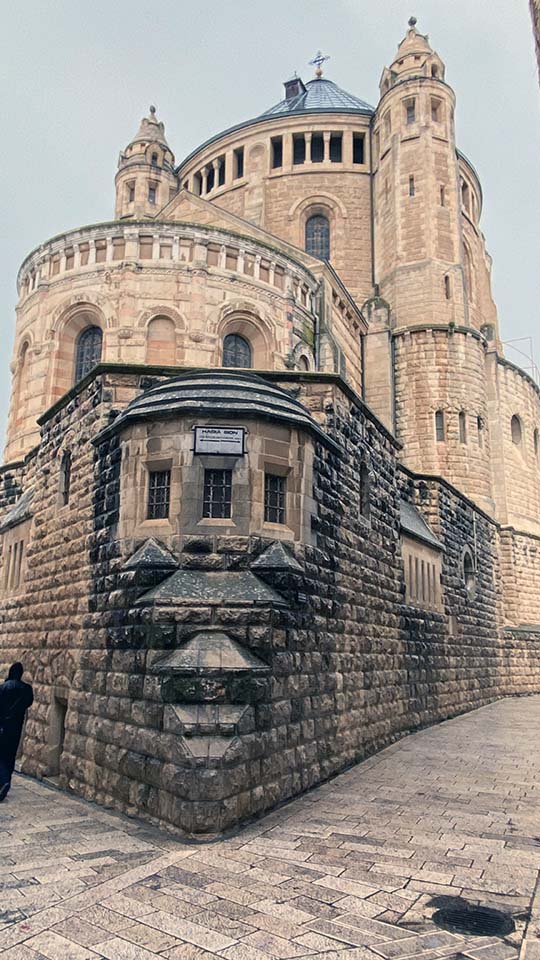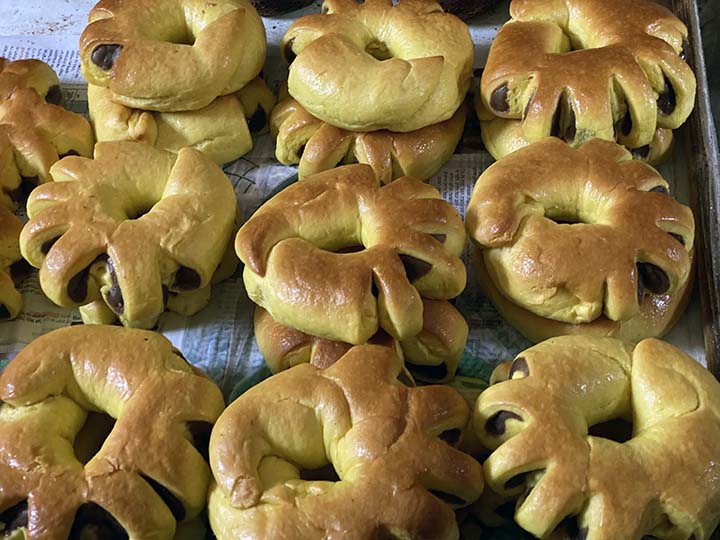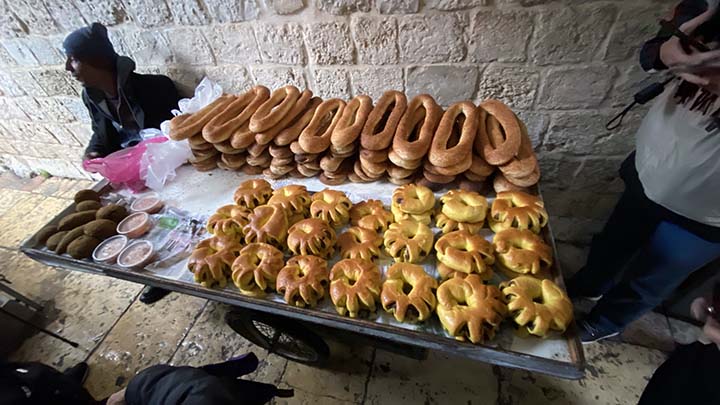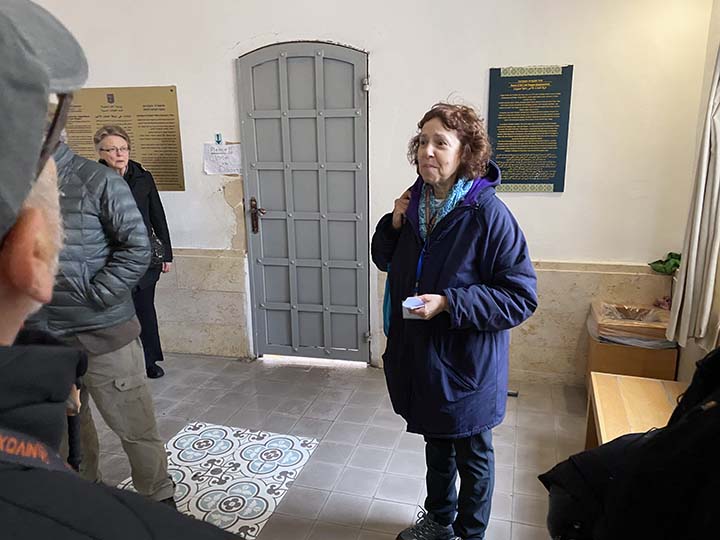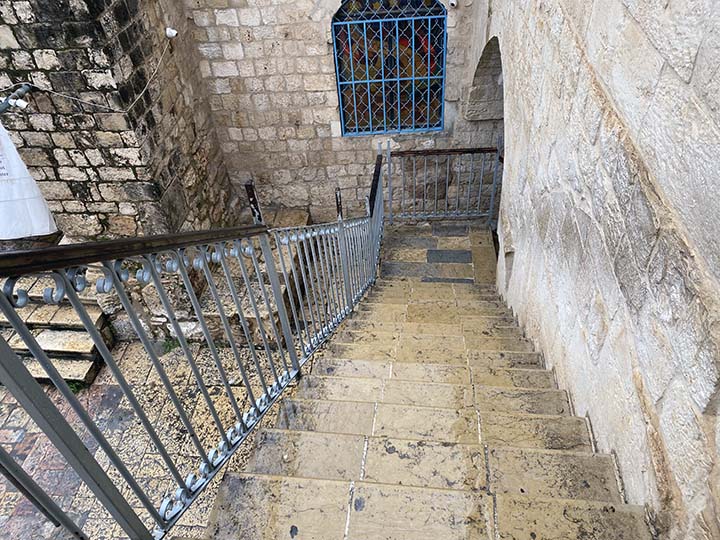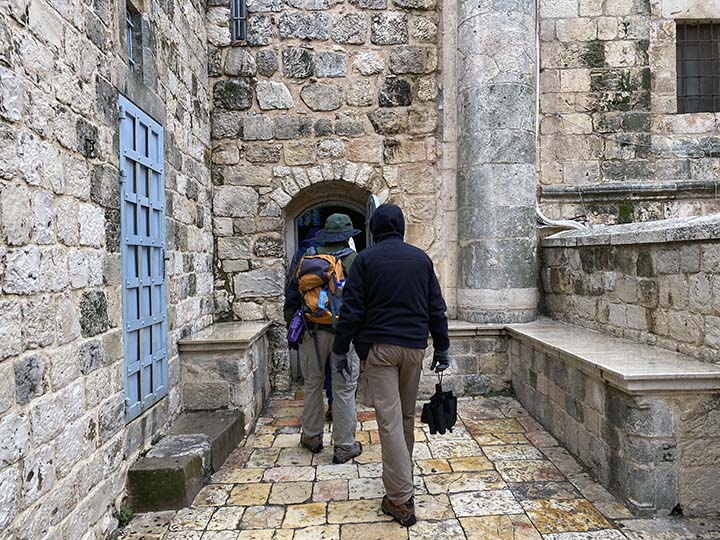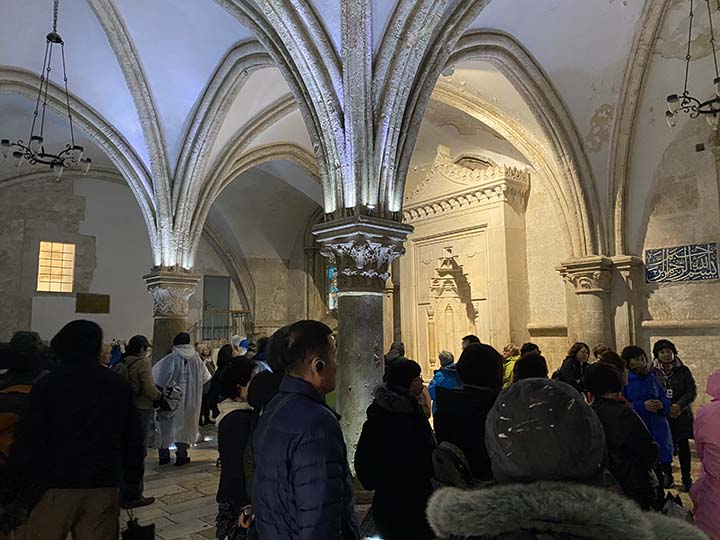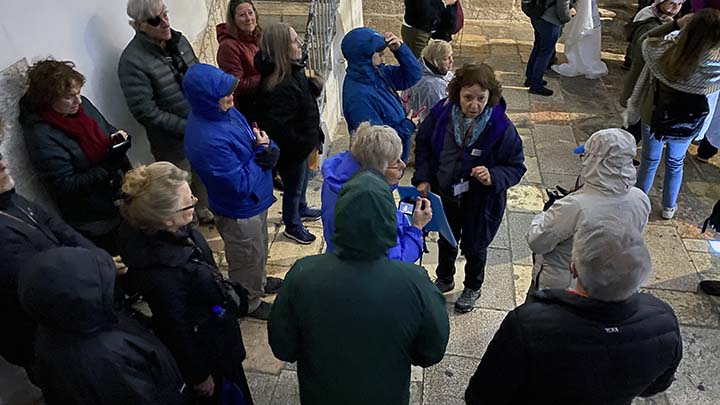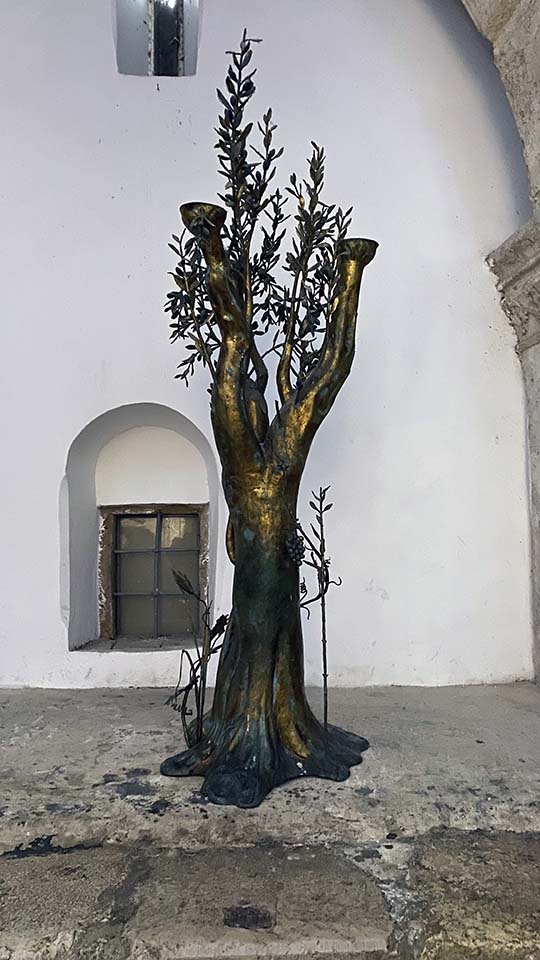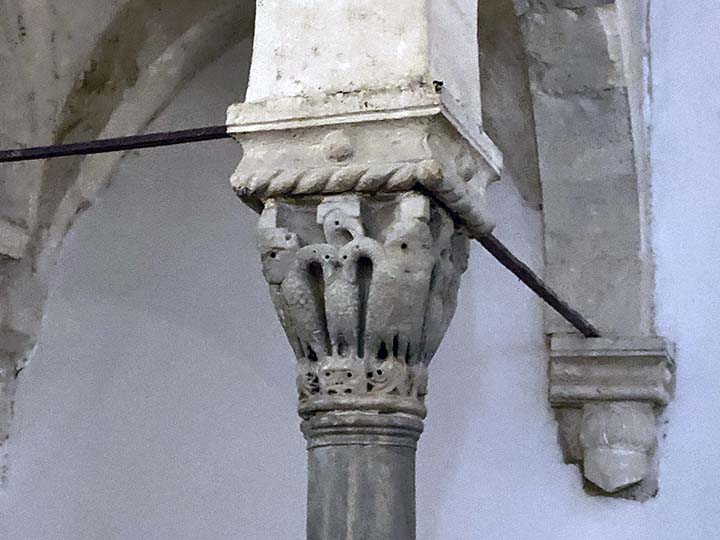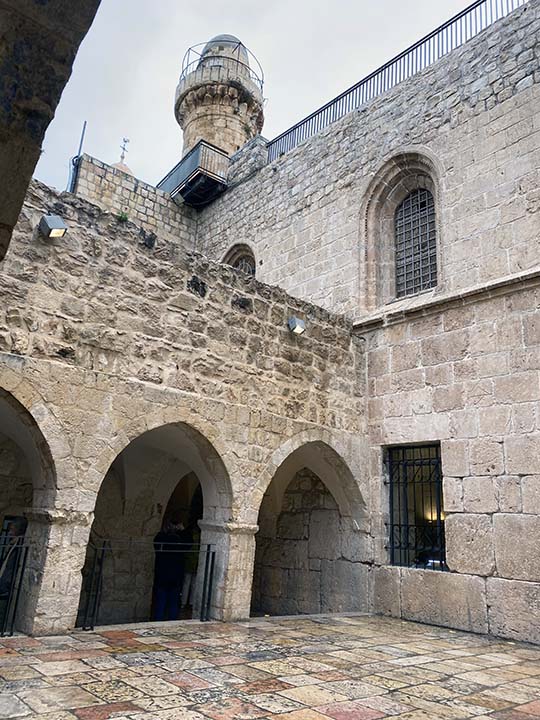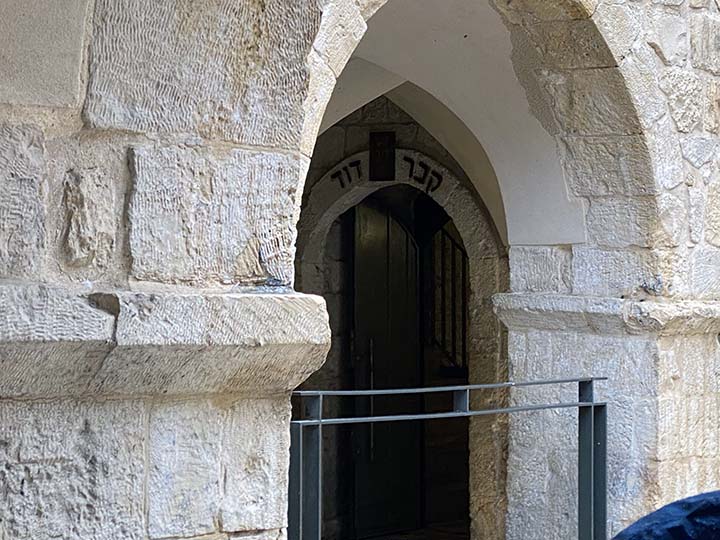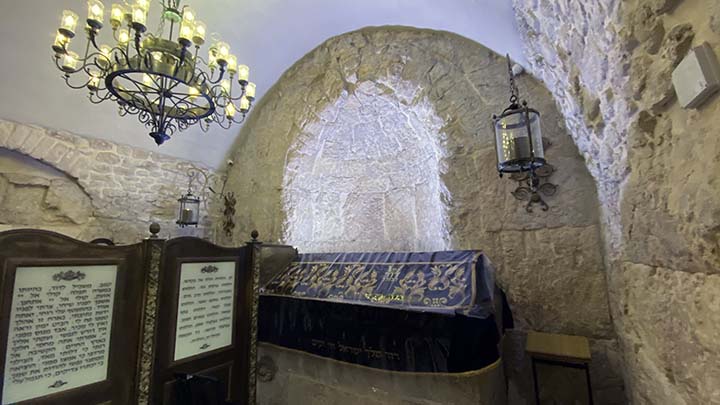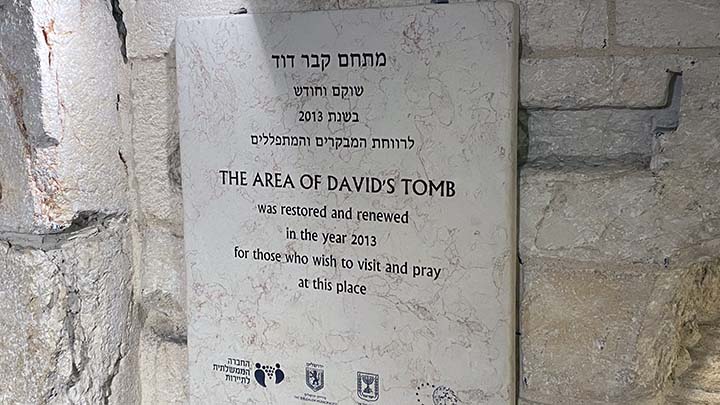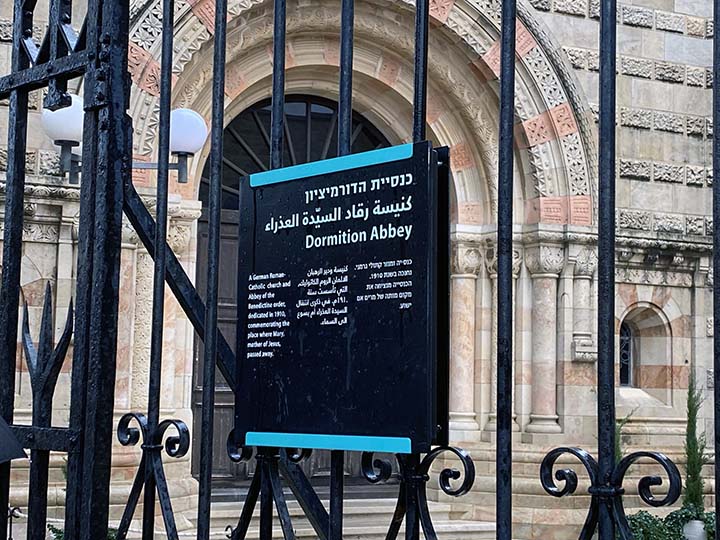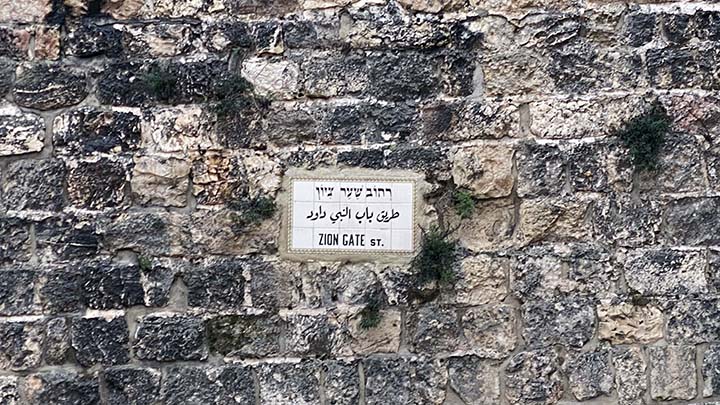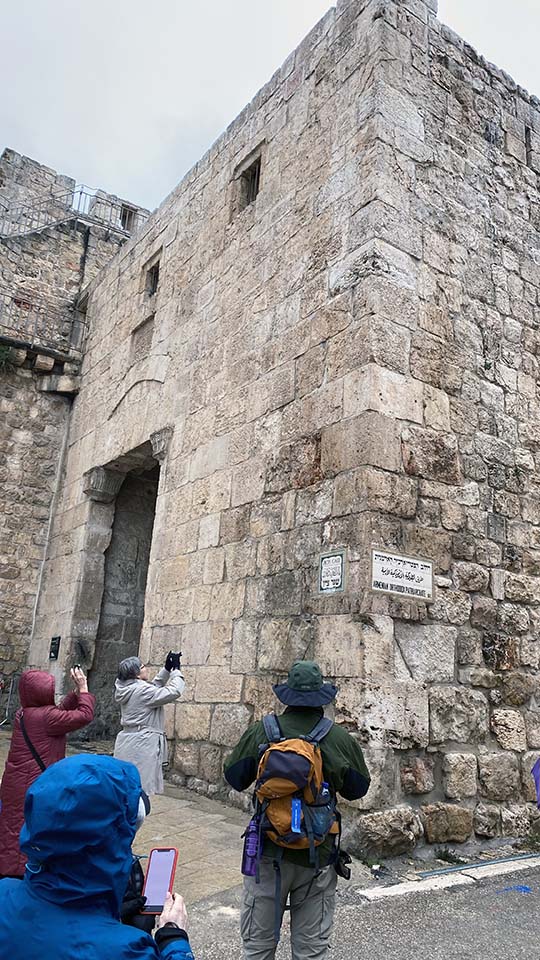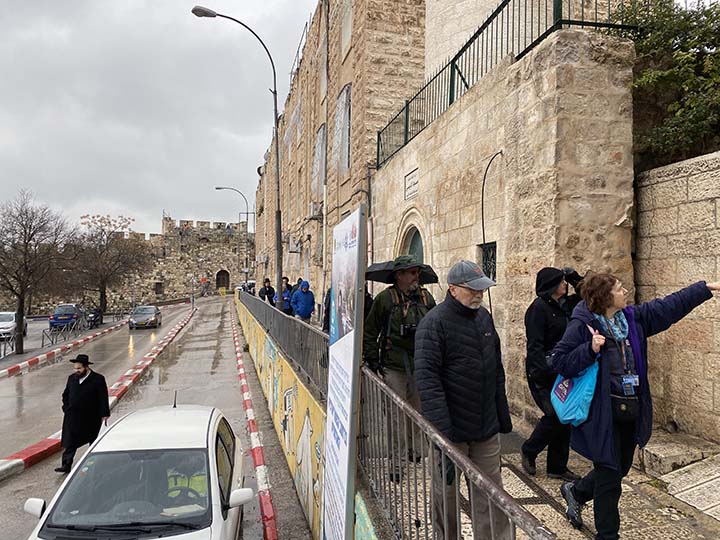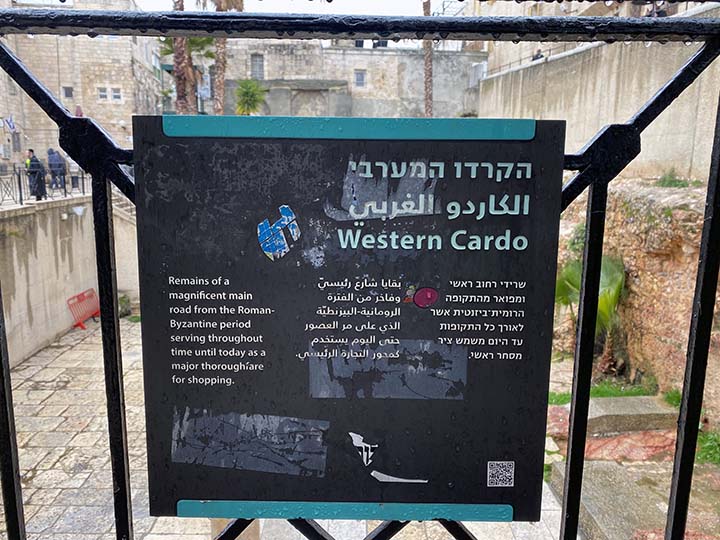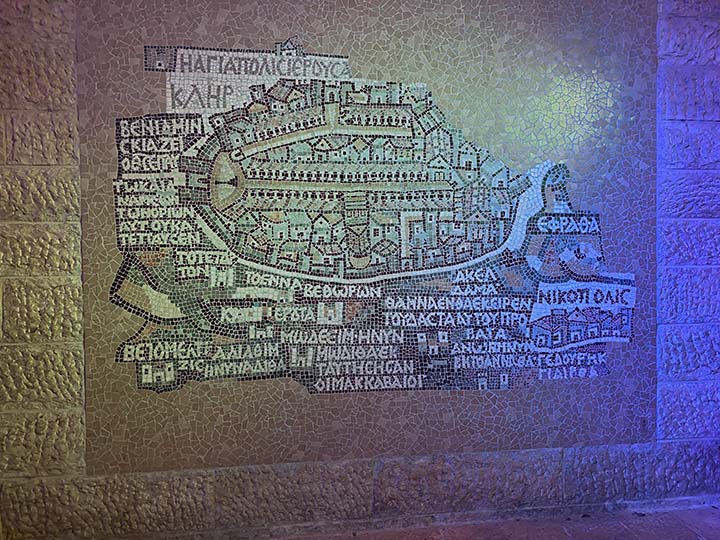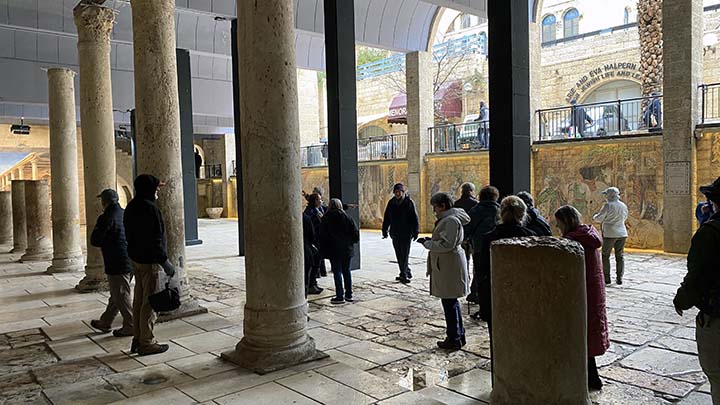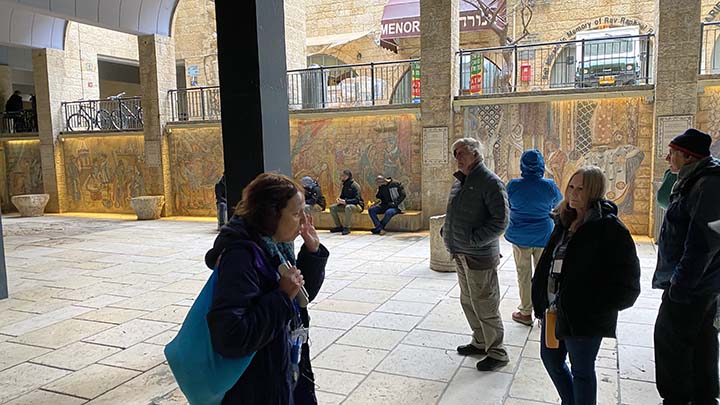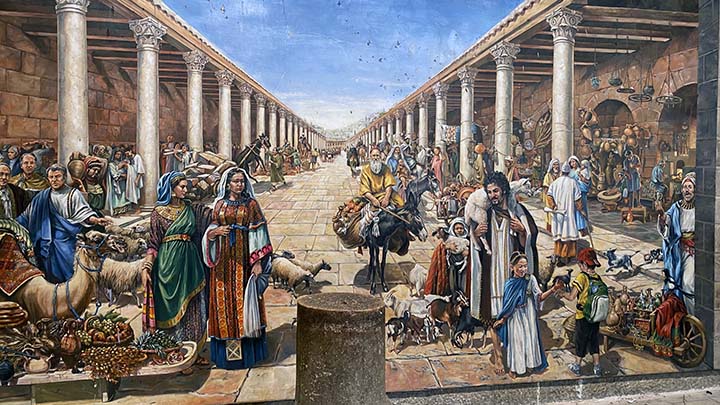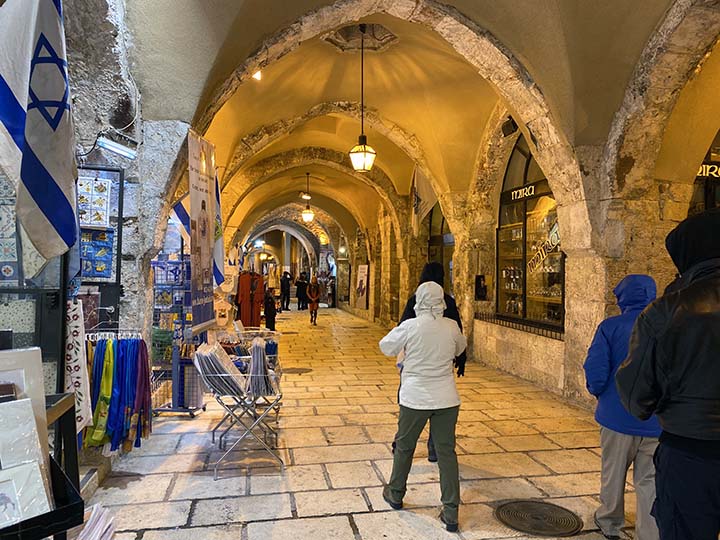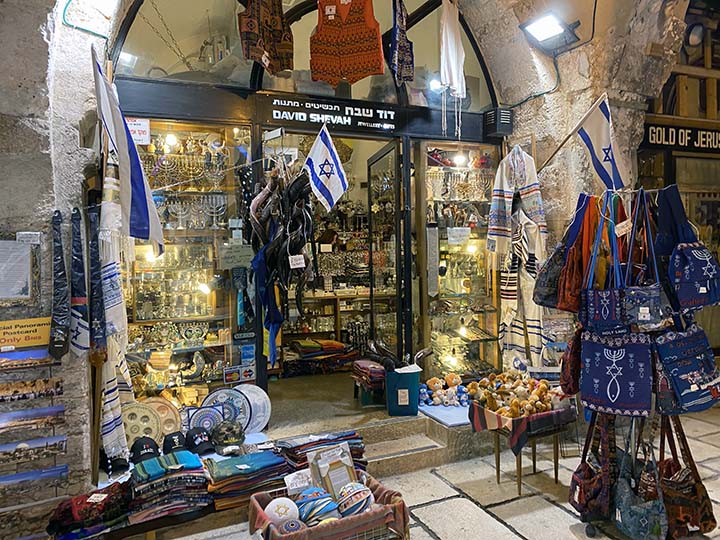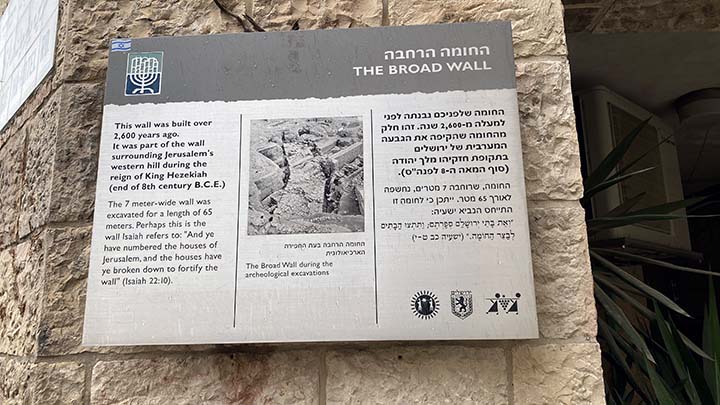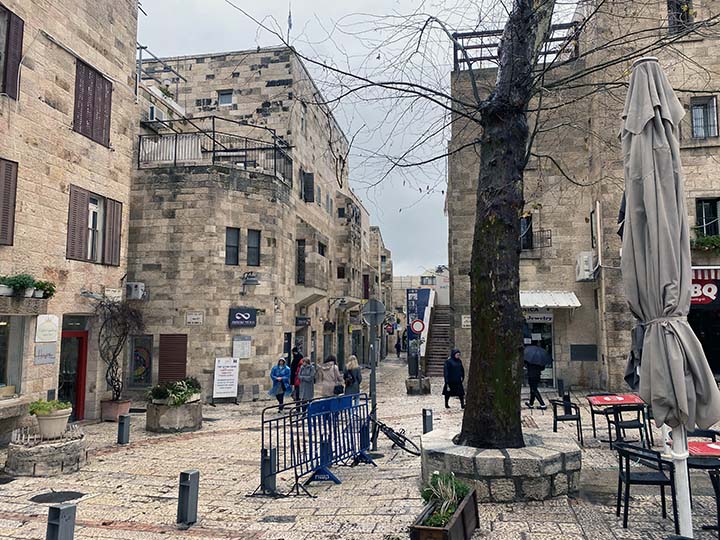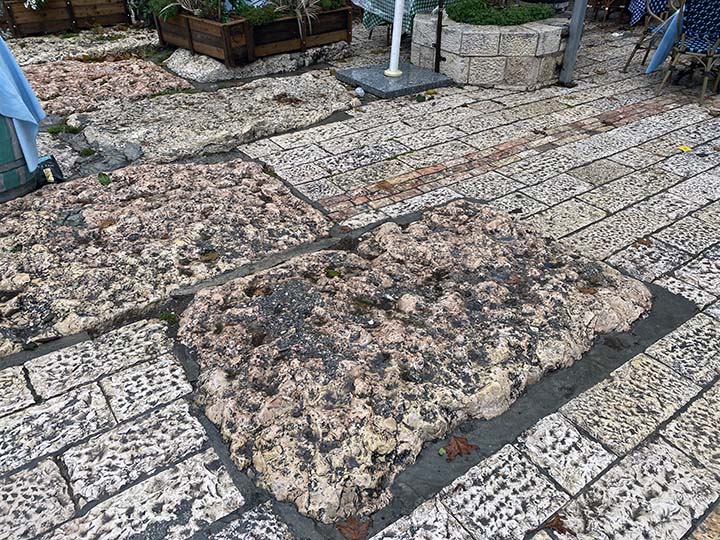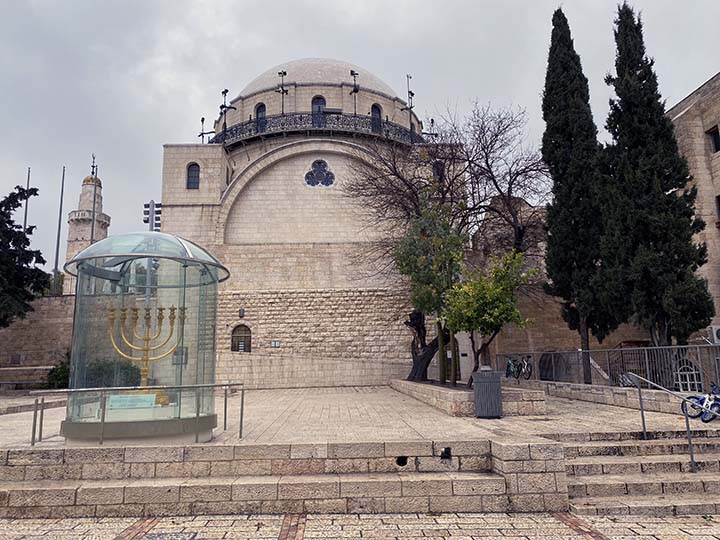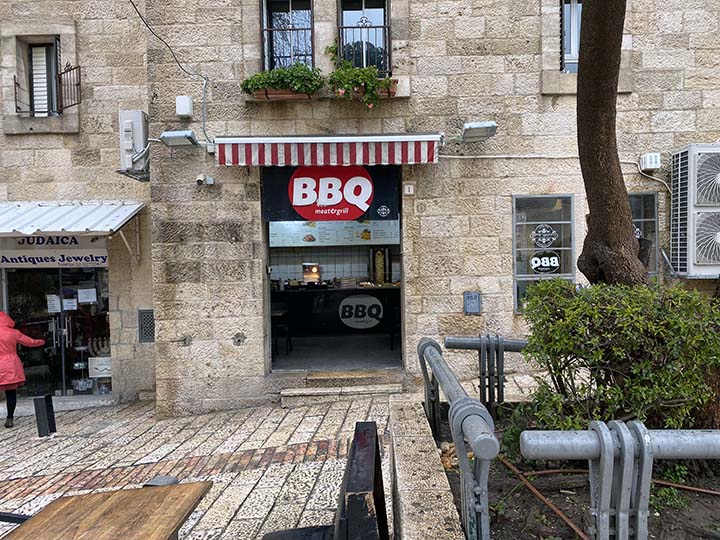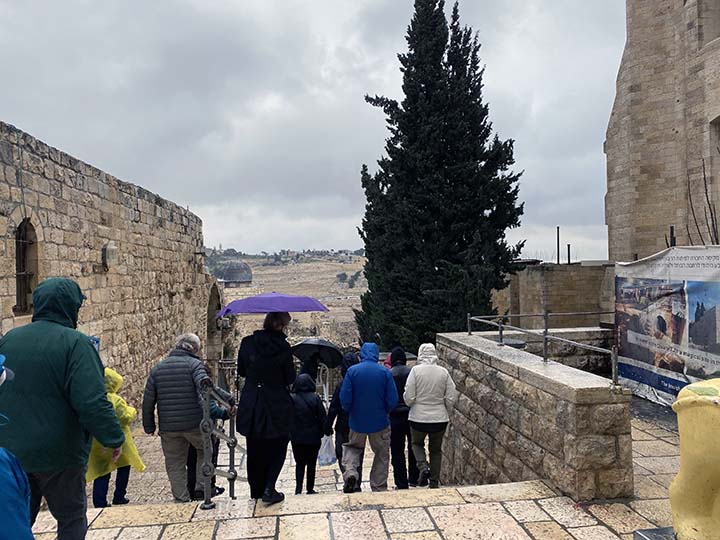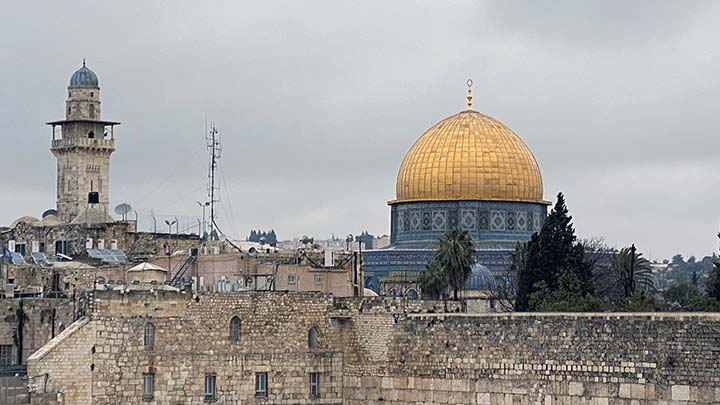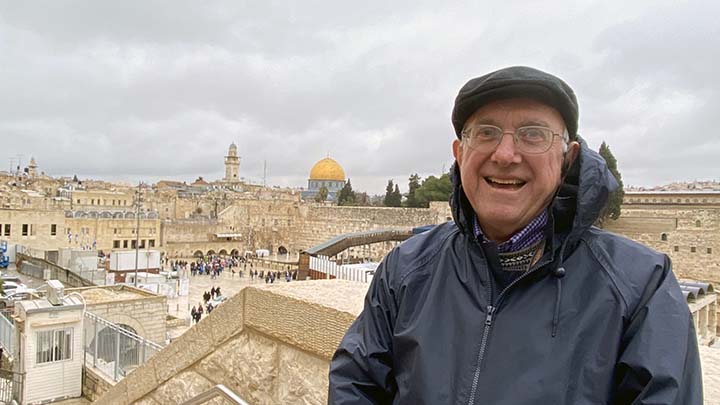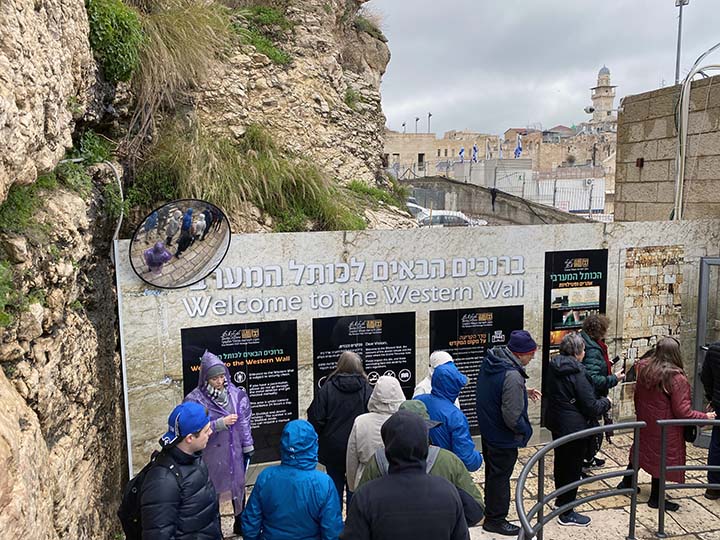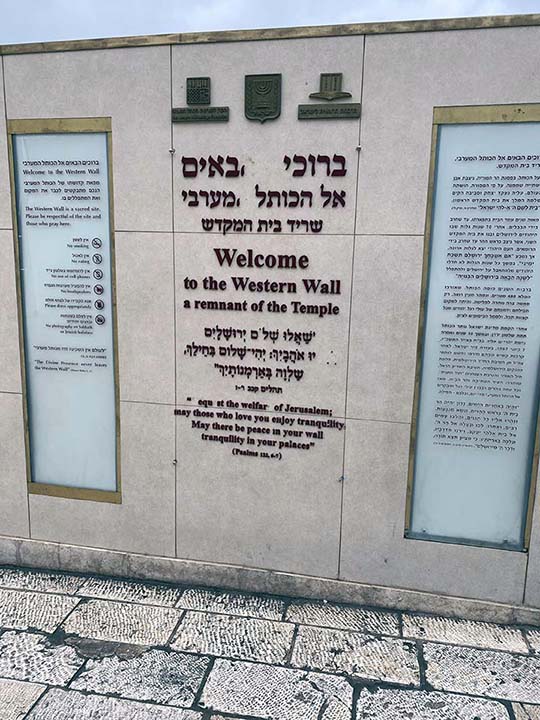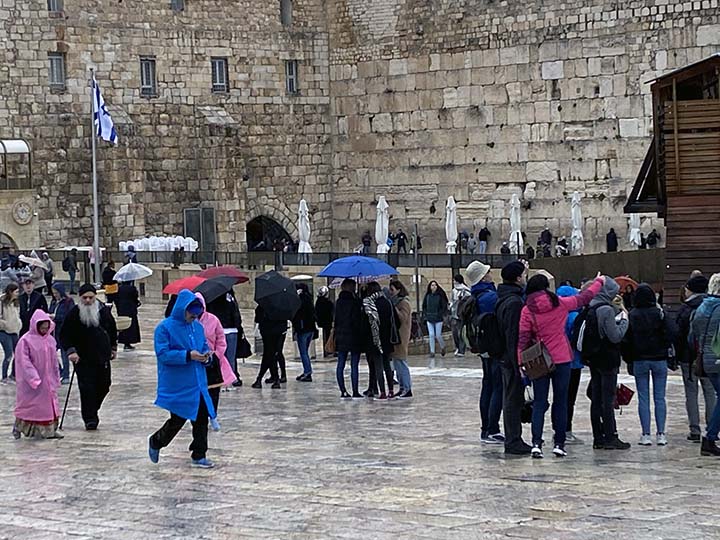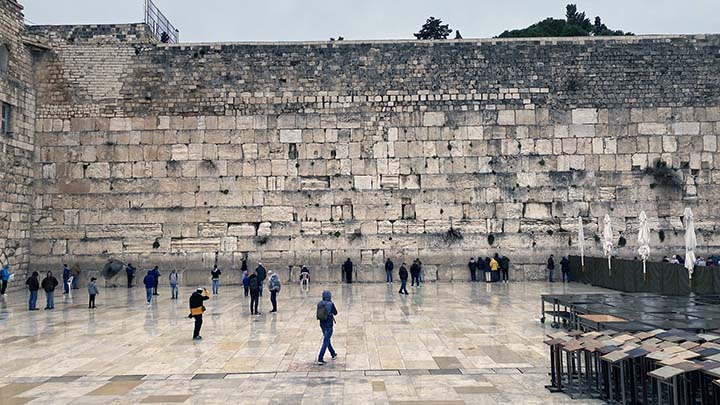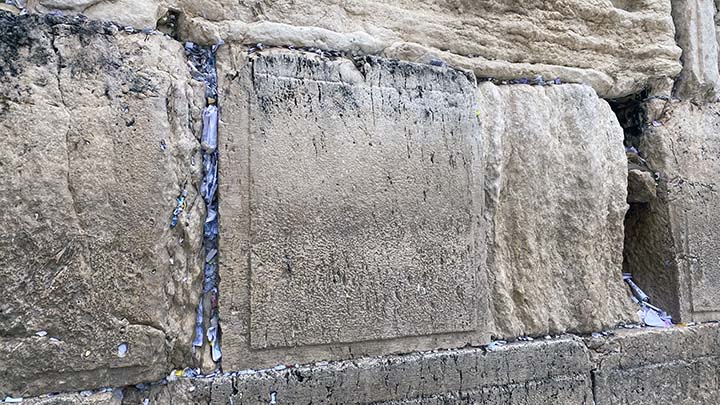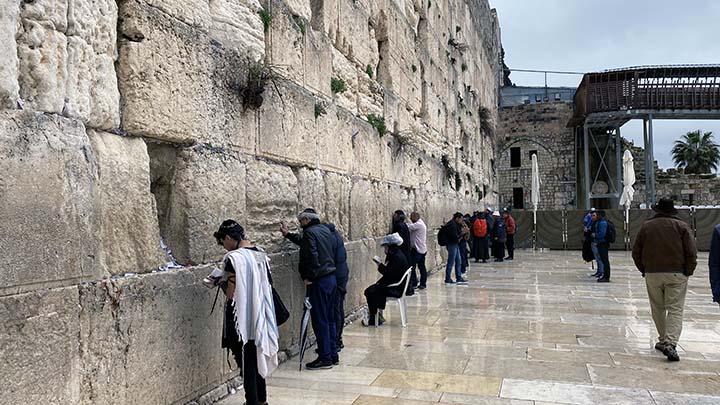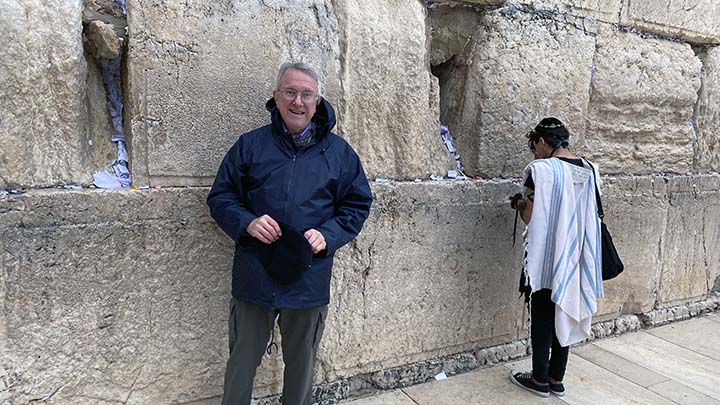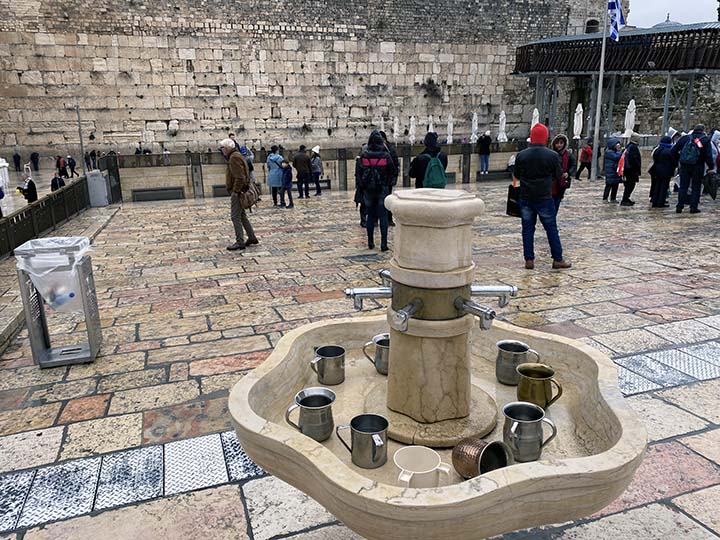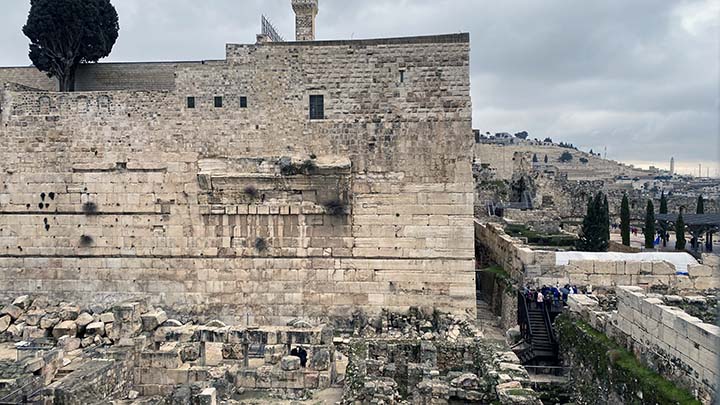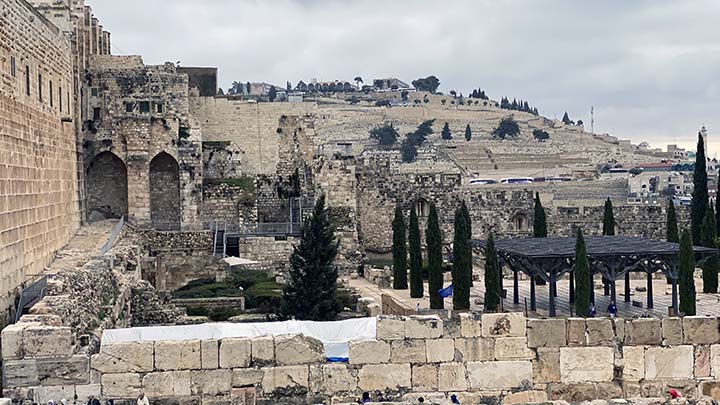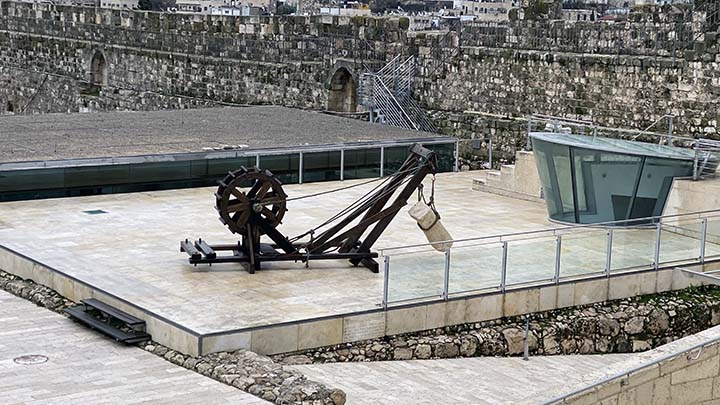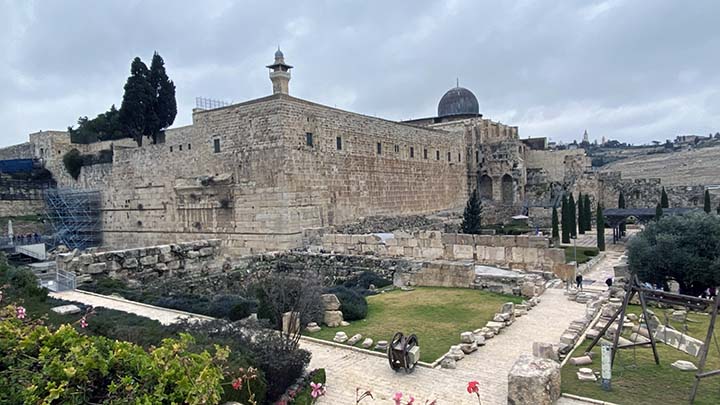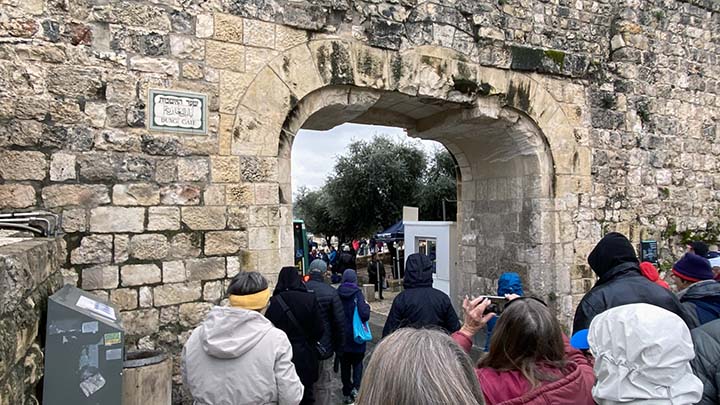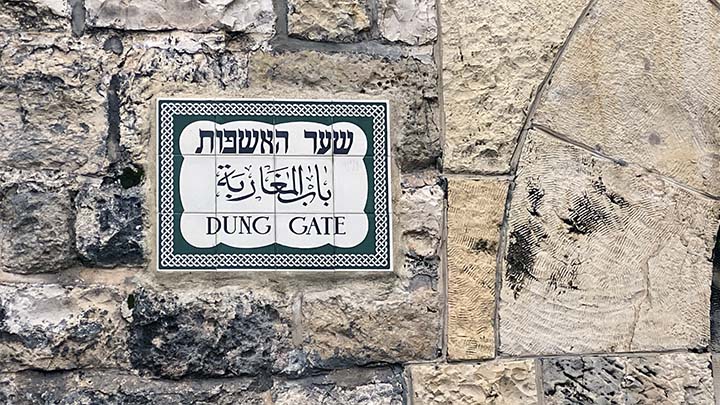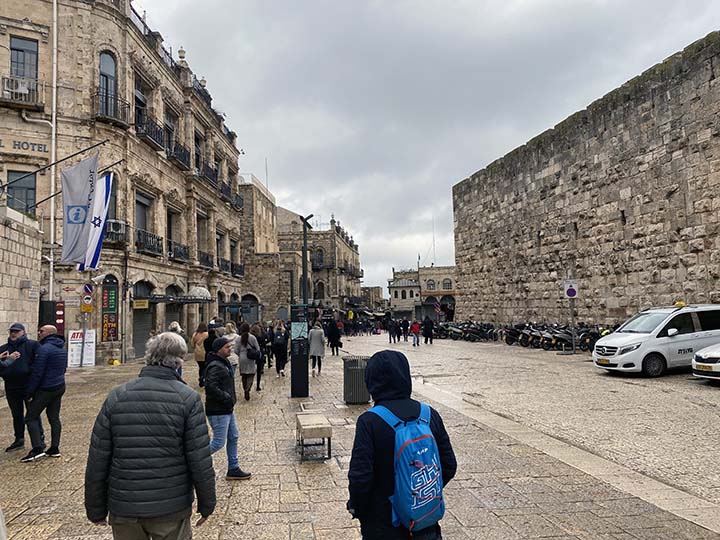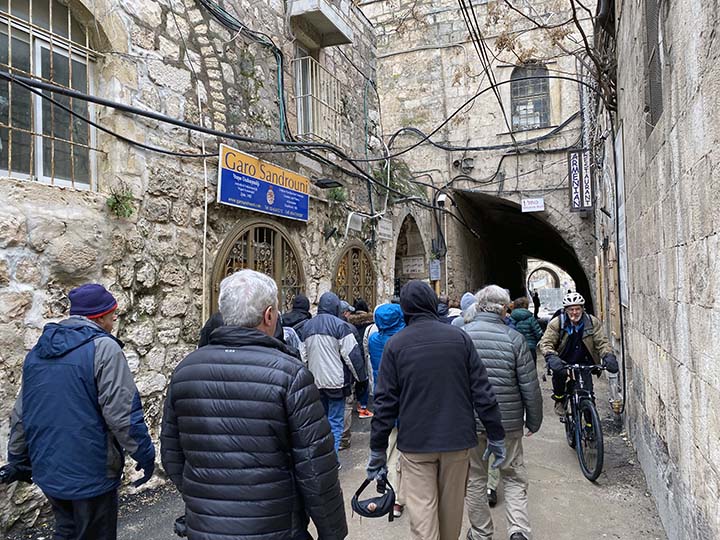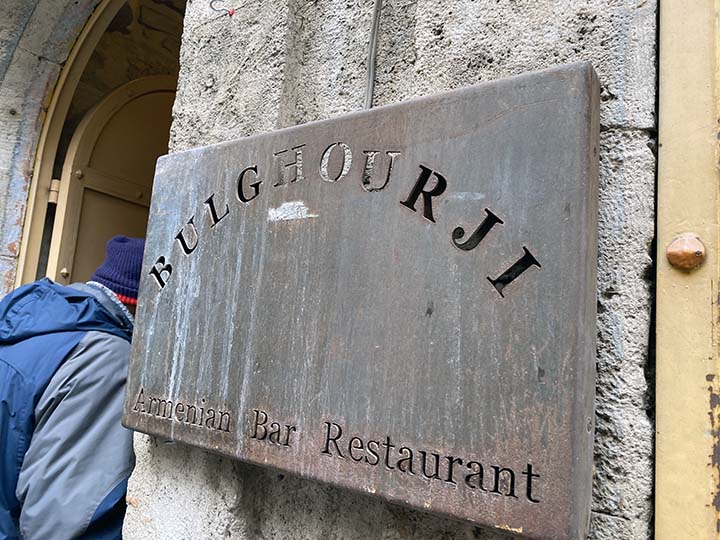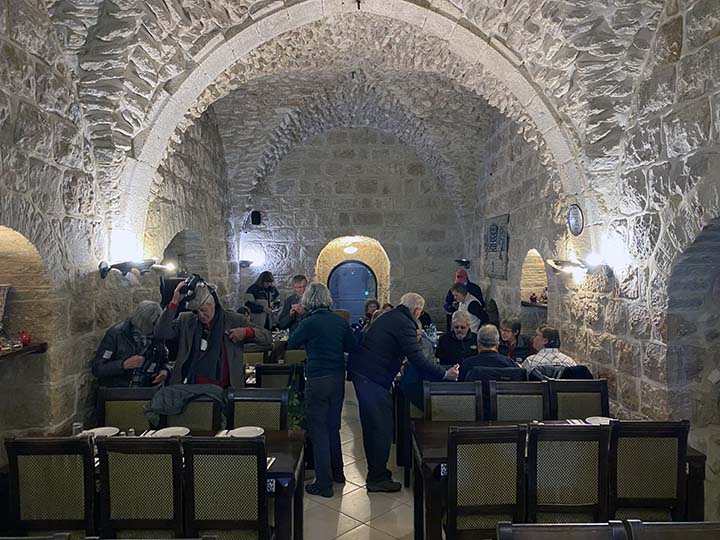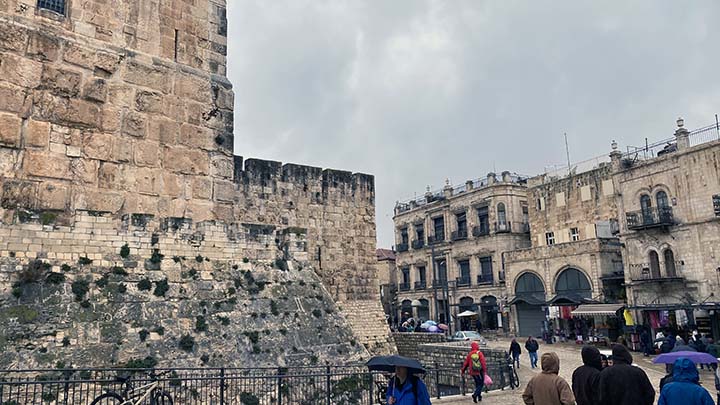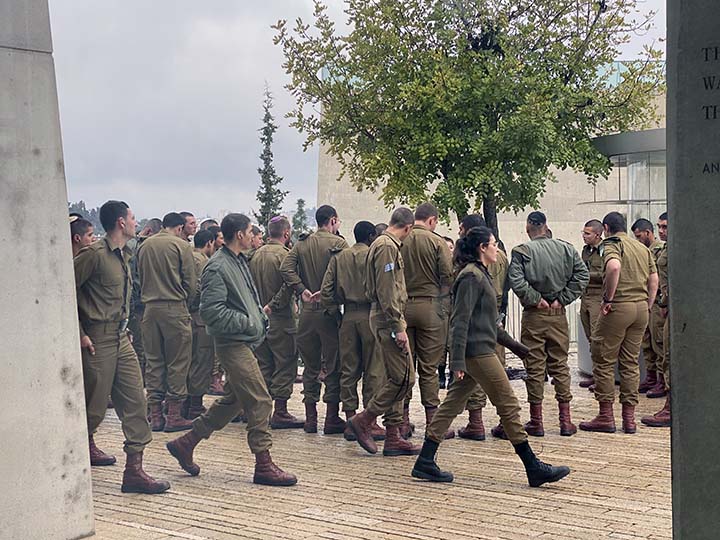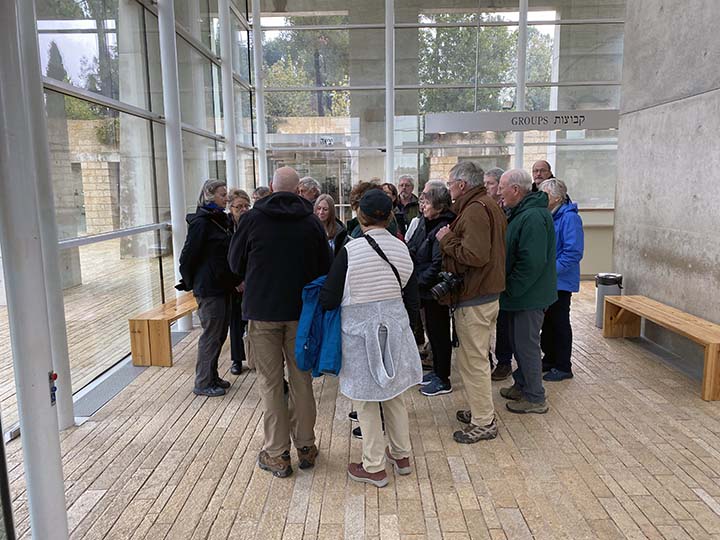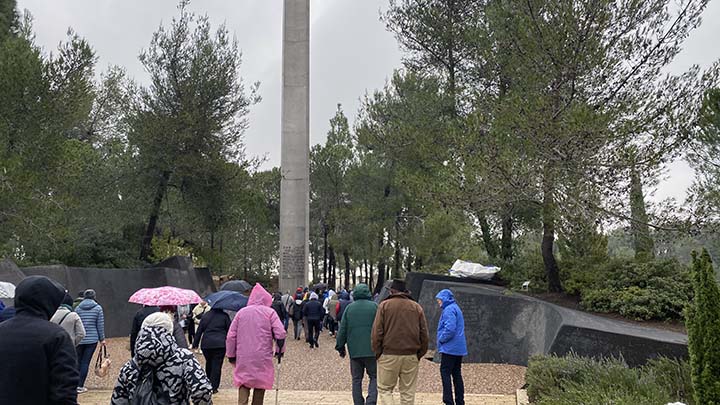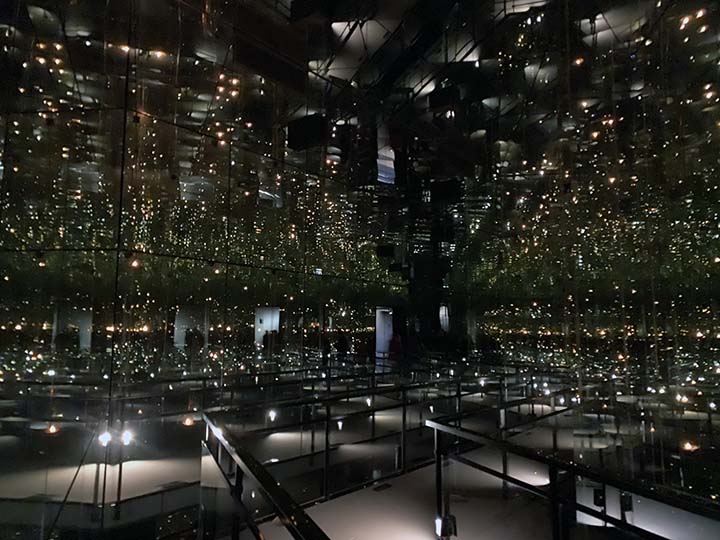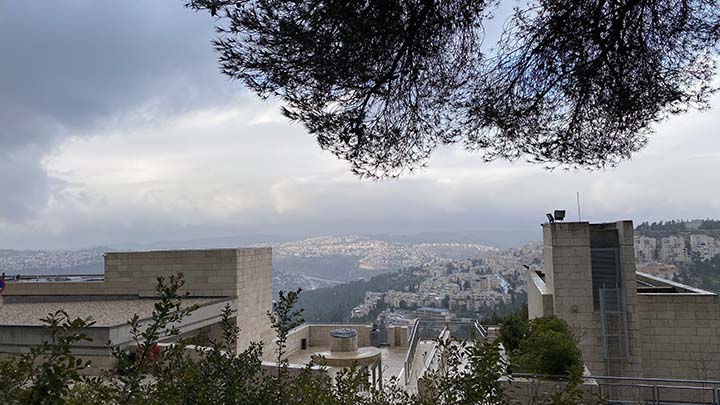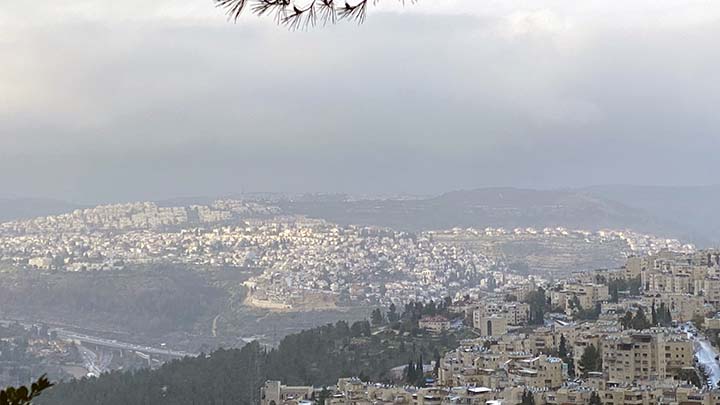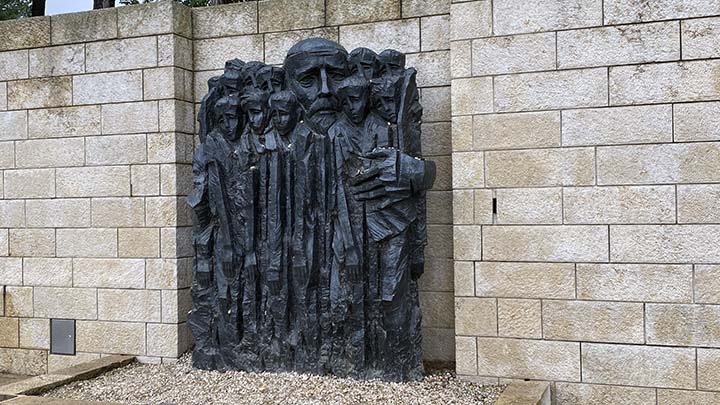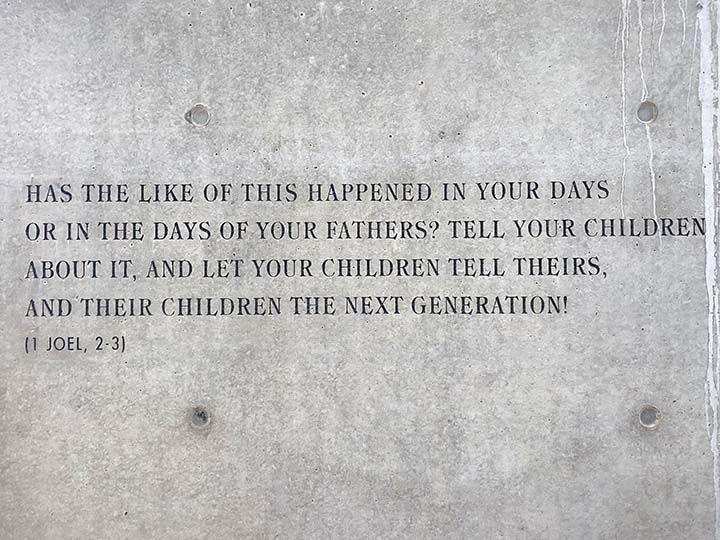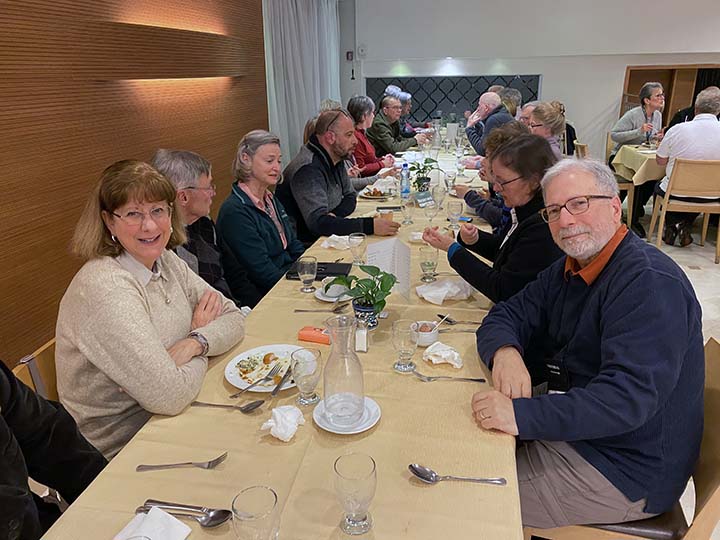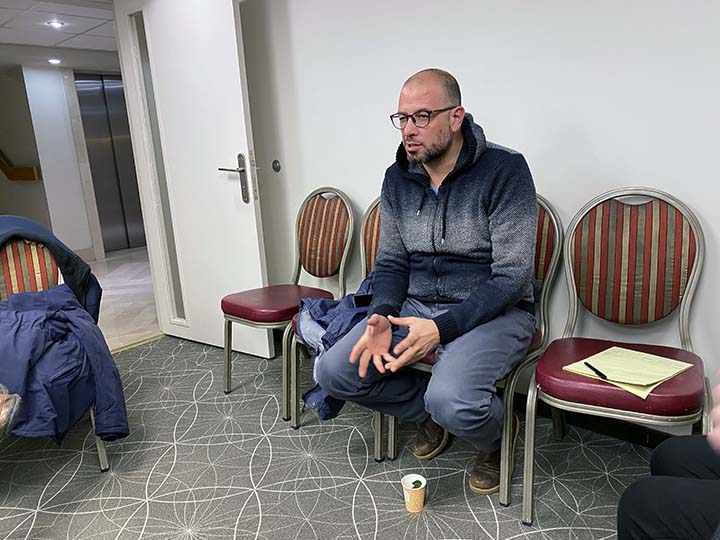|
It’s still cold in Jerusalem, but at least it has almost stopped raining. I think the temperature never rose into the 40s today. But a little chill in the air is no deterrent to the intrepid Road Scholars.
Our first sight from the bus today was maybe more exciting for me than you might guess. That valley down there is called “Hinnom” and was once known by the variation “Gehenna,” which, as I recall from my Bible studies, is another name for Hell.
You can look it up for the full story, but basically bad things happened here: fires burned continuously and bodies were thrown in and, here, let Matthew tell you:
Matthew 23:33, to the Pharisees: "You serpents, you brood of vipers, how shall you to escape the sentence of Gehenna?"
;For a place with such a bad history it looks pretty nice, now.
A garden paradise.
But you probably wouldn't have wanted to hang around here for long back in the day.
The City of David is a Palestinian Arab village intertwined with an Israeli settlement and the archaeological site which is speculated to constitute the original settlement core of Bronze and Iron Age Jerusalem. It is highly controversial in the context of the Israeli–Palestinian conflict as it is located in the area of the West Bank that was annexed to Israel following the 1967 Six-Day War and 1980 Jerusalem Law. Archaeologically it is best known for its Canaanite infrastructure dated to the Middle Bronze Age, and its newer structures from the Iron Age, built by Judean kings. Organized as an Israeli national park, its management was taken over in 1997 by the Ir David Foundation.
We are actually on Mount Zion.
And we are still cold and wet.
But undeterred, we press on.
Now let’s go through the Zion Gate and back into the old city.
Looks like an old intersection up ahead.
This is the site of Hagia Scion (Holy Zion) basilica built in 415 and then destroyed in 614. A few centuries later (13, actually) Kaiser Wilhelm came along and built the Dormition Abbey on the site.
The abbey is to the right. And to the left is an upper room.
There are bagels along the way.
Lots of 'em.
Remember that "upper room" where Jesus met with his disciples just before the crucifixion? Well Shari is about to take us there.
And how do we know that this upper room is THE upper room? Same way we know all that other stuff -- somebody says so. Besides, this room really is upper. I mean I had to climb all those steps to get here.
Well, to get in there.
And there it is. The site of the Last Supper. Does it look like what you expected? Me neither. I guess people come from all over the world to Jerusalem desperate to see the places and things they have read about in the Bible, and would be terribly disappointed to be told it all disappeared centuries ago. So this is a room, and it’s up some stairs, so shouldn’t that be good enough? It is for a lot of people.
It has stained glass, which is appropriate, don't you think?
Besides, if all these people think it's the real upper room, who am I to argue?
Shari explains it all.
A bronze replica of an olive tree is seen in the room. This tree was gifted by Pope John Paul II. The tree symbolizes peace between the three religions – Judaism, Christianity and Islam. There is also a grape vine and wheat shaft representing wine and bread eaten by Jesus and his disciples during the Last Supper.
One of the columns has pelicans sculpted on it. There is mother Pelican bleeding and two baby pelicans feeding on the flesh and blood. This is a symbolic representation of the ultimate sacrifice. This sculpture represents Jesus dying on the cross for the sins of humanity, and so saving the human race. Pelicans. How about that.
I wonder if there's anything interesting under the upper?
Well, coincidentally, it sits directly above King David’s tomb. The Jews are as good at this kind of thing as the Catholics.
There it is right there, King David’s final resting place. “According to tradition.“
And there you have it.
Who wants to argue?
Here’s the Dormition Abbey. It sits on the spot where Mary died. “According to tradition.”
Can you hear the bells? Listen closer.
And back we go into the old city through the Zion gate.
Along with lots of others.
See?
This place is OLD...
Shari makes sure we miss nothing.
Looks like archeologists have been busy here.
This excavation has revealed the ancient Roman Cardo, which is the name of the major north-south road in any city.
See?
Some of those paving stones are original, and others not so much.
It's a map of what this area used to look like.
More excavation has revealed the ruins of an ancient Roman marketplace along the Cardo.
Some of the pavement is ancient, and some of it isn't.
There used top be lots of activity here.
This painting illustrates what it must’ve looked like. See the little girl in the white dress with the blue scarf in the lower right side of the picture? She’s giving some food to a little boy. Enlarge the picture so you can have a good look at him. Nice, huh?
You can still buy stuff here if you really want to.
There's lots to choose from.
This excavation has revealed the remains of the city wall that was in place when Jesus was here.
They call it the broad wall.
This place bustles when the weather isn't cold and rainy.
More old pavement survives.
That's a synagogue.
And that's a barbecue joint. Mmmm, just like home: good old pork barbecue. No, wait.
Just over here there's something special.
No, I'm not talking about the Dome of the Rock.
It's closer...right down there.
The tourist is cold, but he’s happy he isn’t wet like yesterday. Yes, that's the Dome of the Rock in the background. And just below it in this picture, there is a wall.
The Western Wall
It's what's left of Herod's Temple.
The Western Wall, Wailing Wall, often shortened to The Kotel or Kosel, known in Islam as the Buraq Wall, is an ancient limestone wall in the Old City of Jerusalem. It is a relatively small segment of a far longer ancient retaining wall, known also in its entirety as the "Western Wall". The wall was originally erected as part of the expansion of the Second Jewish Temple begun by Herod the Great, which resulted in the encasement of the natural, steep hill known to Jews and Christians as the Temple Mount, in a huge rectangular structure topped by a flat platform, thus creating more space for the Temple itself, its auxiliary buildings, and crowds of worshipers and visitors.
It was destroyed by the Romans a few years after Jesus, but those stones were so big they gave up trying to wreck this part. The name "Wailing Wall", and descriptions such as "wailing place", appeared regularly in English literature during the 19th century. The name Mur des Lamentations was used in French and Klagemauer in German. This term itself was a translation of the Arabic el-Mabka, or "Place of Weeping", the traditional Arabic term for the wall. This description stemmed from the Jewish practice of coming to the site to mourn and bemoan the destruction of the Temple and the loss of national freedom it symbolized.
As it is seen today, the Western Wall measures about 160 feet long and about 60 feet high; the wall, however, extends much deeper into the earth. Jewish devotions there date from the early Byzantine period and reaffirm the rabbinic belief that “the divine Presence never departs from the Western Wall.” Jews lament the destruction of the Temple and pray for its restoration, and it has long been a custom to push slips of paper with wishes or prayers on them into the wall’s cracks.
The Western Wall is free and is open all day, year-round. Women and men should be dressed modestly in the Western Wall Plaza. To pray at the wall, women should have their legs and shoulders covered. Men should cover their head. This section is reserved for men. A partition separates it from a section reserved for women.
The authenticity of the Western Wall has been confirmed by tradition, history, and archaeological research; the wall dates from about the 2nd century BCE, though its upper sections were added at a later date. Texts explaining the survival of the wall vary; one suggests that God saved this fragment for the Jewish people, while another holds that Titus left it as a painful reminder of the Roman defeat of Judea.
The tourist is genuinely moved to find himself at this place.
Looking all around.
If you are really religious, you need to wash your hands carefully before you touch anything.
This excavation has revealed the remnants of what once was an archway over a Roman road. See where are the Archway protrudes from the wall across the way? Jesus could’ve walked under the arch.
It's the place we've read about in the Bible all our lives.
This machine shows how they moved those big blocks of stone back in the day.
Clever, huh?
Soon we'll say goodbye to old Jerusalem.
We are passing through a gate in the wall. This is where in the old days all the sewage left the city.
Told you.
Still a few sights left, though.
We have seen so many places held by many to be sacred because of their association with Jesus when in fact nobody knows for sure. This tower, on the other hand, was definitely standing during the time of Jesus. He saw that tower, just like we are looking at it now. Gave me a few goosebumps.
It was called the Tower of David.
Like I said.
Let's have lunch before we leave.
Should be a nice place.
And so it is. Lots of dungeon-like atmosphere.
But we gotta go.
That is Yad Vashem, Israel’s memorial to the victims of the Holocaust.
Sort of like our visit to Auschwitz on the trip to Central Europe, this is not something to look forward to, but it is something important to experience.
It seemed like the entire Israel army had come here to tour with us. And that is what they were here for: to see the place and presumably come to a better understanding of what they fight for.
The Road Scholars map out a plan to tour the memorial.
There are large exhibition areas where photos are not permitted, and there are outdoor areas as well.
It was a very moving experience, much like visiting the Holocaust Museum in Washington DC. One room was devoted to the murders of over 1 million people at Auschwitz.
Another outdoor installation was dedicated to the children who were killed in the Holocaust.
A group of young women was visiting.
More exhibit area.
This dark room which featured light and mirrors reminded us of the lives of those who were lost.
This memorial singles out the children who were lost.
I snapped a picture quick as I could when sunlight momentarily broke through the clouds. Didn’t last long.
There...sun...really!
Here’s another sculpture reminding us of the children who were lost.
I thought this quote from the book of Joel perfectly captures the inspiration behind Yad Vashem.
There was a mix-up with this afternoon’s lecture, So we had an early dinner while we waited for our speaker to arrive. He was Palestinian and he had to make his way to our hotel from his home which was about only about 6 miles away. Trouble is, it was on the other side of the separation wall that keeps the Palestinians away from the Israelis, and this afternoon Palestinian kids decided to start throwing rocks at Israeli soldiers. As our speaker said when he finally arrived, “It’s not good to get caught between kids throwing rocks and soldiers firing guns.
His name was Hassan Mitwali and he gave us a presentation on the current status of relations between Palestinians and Israelis. Just like last night’s Israeli presenter he was charming and eloquent and diplomatic and totally pessimistic. He sees no hope for a settlement in the foreseeable future. He concluded with a statement that made all of us laugh because it so closely echoed what the presenter last night also said: “We need leadership.”
|



